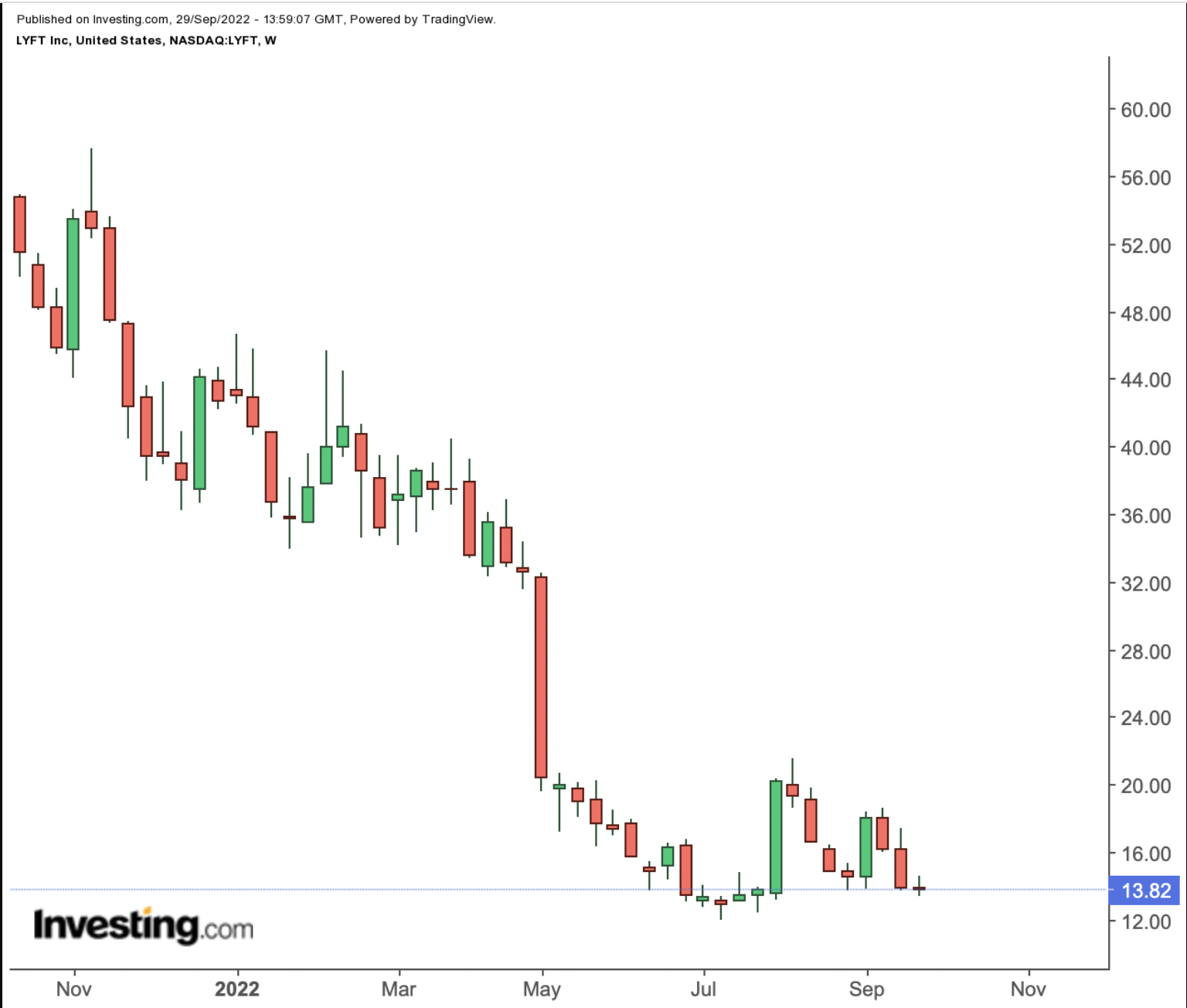Can A New Lyft Finally Create Value For Shareholders?
2022.09.29 13:40
[ad_1]
- LYFT stock has been a disappointment since the 2019 IPO, and now trades below even March 2020 lows
- Management is targeting $700 million in free cash flow in 2024, a target which could drive LYFT from current levels
- But macro pressures and stock-based compensation raise concerns about 2024 targets and about Lyft stock
In March 2019, Lyft (NASDAQ:) priced its initial public offering at $72 per share. A year later, as the scale of the novel coronavirus pandemic became clear, the stock bottomed at $16. Incredibly, LYFT closed Wednesday at $14.50, below the worst of the March 2020 trading and down almost 80% from the IPO price.

Source: Investing.com
On their own, those declines don’t make a bull case for LYFT stock. The lower valuation here makes some sense. Neither Lyft nor its larger rival Uber (NYSE:) has been able to turn the ride-sharing model into true profitability. And while investors were willing to pay almost any price for growth in 2019 — and willing to fund losses to drive that growth — attitudes have changed. The market is looking for profitability and free cash flow.
But the lower valuation certainly helps the bull case here. So does Lyft’s plan to drive the cash flow investors are seeking. The two key questions are whether Lyft’s plan will work — and whether even success is priced into LYFT stock.
Ugly Fundamentals
There is a simple argument against LYFT at the moment: the fundamentals remain unimpressive.
Based on Wall Street estimates, Lyft’s revenue should grow 28% this year compared with 2021. But, of course, last year’s revenue was pressured by the lingering impacts of the pandemic on travel. The full-year estimate for 2022 revenue only suggests about 14% growth against 2019 levels.
Meanwhile, that revenue isn’t profitable. The consensus estimate implies earnings of 41 cents per share this year — but the estimate is based on Lyft’s adjusted figures. Lyft excludes stock-based compensation from its calculation of adjusted EPS — and that compensation is substantial.
Through the first half of the year, Lyft has booked $330 million in stock-based compensation. Adjusted EBITDA (earnings before interest, taxes, depreciation and amortization) totaled just $134 million.
Since Lyft went public (actually two months before Uber), critics have argued that the ride-sharing model simply can’t drive a profitable business. Neither Lyft nor Uber has disproven the critics yet.
The 2024 Targets
But Lyft said after the that it would indeed start generating profits. In 2024, the company is targeting $1 billion in adjusted EBITDA and $700 million in free cash flow.
Both targets suggest substantial upside in Lyft stock, which is why shares soared after the earnings report. Lyft currently has an enterprise value of about $4.4 billion. Even relatively conservative 10x EV/EBITDA and 20x P/FCF multiples suggest the stock could more than double, and maybe triple, if management delivers.
Of course, there’s plenty of cause for skepticism toward those targets, not least the company’s current performance. Lyft is only guiding for an adjusted EBITDA margin of 5% to 6% in the third quarter; the target requires that figure to expand to nearly 20% less than two years from now.
There are macroeconomic concerns that could arise along the way. Airport trips, for instance, are highly profitable for Lyft, but a recession could pressure air travel and, thus, the need for those trips. Higher insurance rates already are becoming a problem, one that could be exacerbated by further inflation in repair costs and other factors.
That said, there’s something important to remember here: this is a platform model. Lyft’s revenue is only its share of take from individual trips. As that revenue rises, Lyft’s costs increase at a much slower rate.
This is what is known as “operating leverage” — and Lyft already has shown some of that leverage to this point. With cost-cutting likely on the way after a recent hiring freeze, a rapid expansion in profit margins isn’t quite as unlikely as it might seem.
Is Success Priced In?
There’s one catch, however: even those targets might be close to being priced in.
Again, Lyft’s adjusted EBITDA figures exclude stock-based compensation. So do free cash flow figures (since stock-based comp is a non-cash expense).
A total of $700 million in free cash flow sounds like a big figure. But assuming share-based comp stays at current levels, the majority of that cash flow simply comes from paying employees partly in LYFT stock. The same is true for EBITDA.
Adjusted for that compensation, and even assuming targets are hit, LYFT is trading at perhaps 18x 2024 free cash flow and 11x adjusted EBITDA. That’s still probably too cheap — but, again, there’s no guarantee those targets indeed will be hit.
So right now, LYFT stock is a bet on those targets. In this market, and with economic risks swirling, that does seem like a tough bet to take.
Disclaimer: As of this writing, Vince Martin has no positions in any securities mentioned.
[ad_2]
Source link








